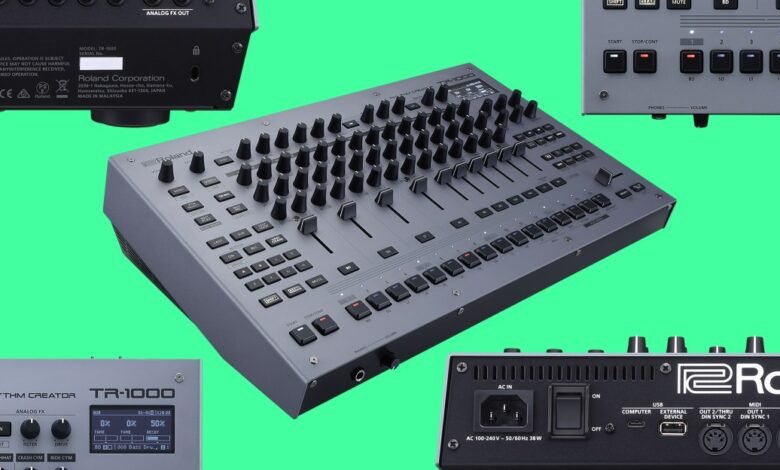Roland Embraces Its Legacy, Not Just Its Past

▼ Summary
– The Roland TR-808 is a historically significant instrument that has been a cornerstone of hip-hop, electronic, and pop music for 45 years.
– Roland was highly innovative in the 1980s and ’90s but lost its way in the 2000s by producing forgettable digital products and exploiting its heritage.
– The company shifted to digital modeling and emulation of its analog classics, which sounded good but disappointed those wanting authentic analog reissues.
– Competitors like Behringer and Korg capitalized on the demand for analog gear by offering recreations and modern classics while Roland focused on digital emulations.
– The TR-1000 marks a return to Roland’s analog roots, featuring recreated analog circuits from the TR-808 and TR-909 without requiring subscriptions or excessive digital menus.
For over four decades, Roland has cemented its reputation as a foundational force in music production, largely thanks to the legendary TR-808. This drum machine fundamentally reshaped modern music, becoming an indispensable tool for genres ranging from hip-hop and electronic to mainstream pop. Its distinctive sounds have powered tracks by an incredibly diverse array of artists, from Whitney Houston and Rihanna to Outkast and RP Boo. Throughout the 1980s and 90s, Roland stood at the forefront of innovation, consistently releasing iconic analog synthesizers and pioneering rhythm machines that defined the sonic character of entire eras.
However, the company’s direction shifted noticeably in the 2000s. This period saw the release of a series of all-digital products that failed to capture the imagination of musicians. Instruments like the D-2 GrooveMachine and the VariOS felt disconnected from the brand’s rich history. For roughly the last ten years, Roland’s strategy appeared to center on reminding everyone of its past glories, often through methods that many viewed as misjudged. This included pushing a subscription-based service and seemingly turning its back on the analog foundations that built its legacy.
A key point of contention was Roland’s naming conventions. The company repeatedly invoked its heritage with products branded as the MC-808, SP-808, and numerous Juno and Jupiter variants. Yet, these new instruments shared almost no technical or sonic DNA with their iconic namesakes, leaving many fans feeling shortchanged.
Now, a significant change seems to be underway. With the introduction of the TR-1000 Rhythm Generator, Roland is not just referencing its past; it is genuinely embracing it. This is a serious, professional-grade instrument, with a price tag to match, that marks a return to genuine analog circuitry. By the close of the 1980s, Roland had fully committed to digital technology, largely abandoning the analog designs responsible for its most beloved gear. While this digital pivot was an industry-wide trend, a cultural shift began in the 2000s as a new generation of artists started seeking out the warmth and character of analog gear, which was becoming affordable on the secondhand market.
Despite this growing demand for vintage sounds, Roland remained steadfast in its digital approach. The company eventually recognized that musicians wanted more than just nostalgic branding on modern digital devices. Yet, instead of producing new analog instruments or faithful reissues, Roland doubled down on digital modeling. Its Analog Circuit Behavior (ACB) technology aimed to replicate analog sound through software emulation. This direction was understandable given the company’s decades of investment in digital R&D, coupled with the practical challenges of working with analog circuits and a loss of specialized engineering talent.
The 2014 release of the TR-8 was seen as a step in the right direction, billed as a spiritual heir to the 808. However, it was a fully digital device, launching what some critics termed Roland’s “close enough” era. While ACB-based instruments like those in the Boutique line were generally considered to sound good, a persistent demand remained for authentic analog recreations. This gap in the market was eagerly filled by competitors. Behringer capitalized by releasing a series of affordable analog clones of classics like the TR-808, TR-909, and TB-303. Simultaneously, Korg won over musicians with modern analog synths like the Minilogue and its playful Volca series, alongside faithful reissues of vintage icons.
Throughout this period, Roland seemed content offering its popular synth emulations in the pint-sized Boutique format, often requiring an additional, costly purchase to attach a keyboard. This approach stood in stark contrast to the offerings from its rivals.
The TR-1000, therefore, represents a major departure and a significant statement. It is Roland’s first true analog drum machine since the TR-909 was discontinued in 1983. The development team meticulously recreated the analog circuits for 16 core sounds from the legendary TR-808 and TR-909, utilizing modern components for reliability and consistency. Importantly, the instrument does not lock its features behind a subscription service, and it avoids the flashy, distracting light shows found on other modern gear like the Aira family. With a wealth of hands-on physical controls, the TR-1000 promises a more immediate and intuitive experience, potentially freeing users from the notoriously complex menu diving that has often plagued Roland’s interfaces.
(Source: The Verge)
